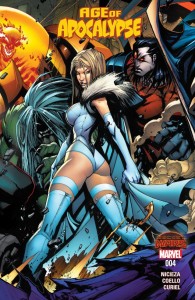 Secret Wars: Age of Apocalypse #4 (of 5) — Writer: Fabien Nicieza; Art: Iban Coello; Colors: David Curiel
Secret Wars: Age of Apocalypse #4 (of 5) — Writer: Fabien Nicieza; Art: Iban Coello; Colors: David Curiel
Secret Wars: Guardians of Knowhere #4 (of 4) — Writer: Brian Michael Bendis; Art: Mike Deodato; Colors: Frank Martin
Secret Wars: House of M #3 (of 4) — Writers: Dennis Hopeless and Cullen Bunn; Art: Ario Anindito; Colors: Matthew Wilson
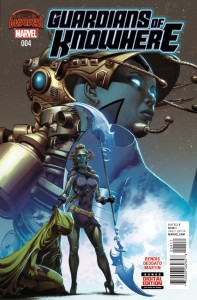 Secret Wars: The Infinity Gauntlet #4 (of 5) — Story/Artist: Dustin Weaver; Script: Gerry Duggan; Colors: Rain Beredo
Secret Wars: The Infinity Gauntlet #4 (of 5) — Story/Artist: Dustin Weaver; Script: Gerry Duggan; Colors: Rain Beredo
Secret Wars Journal #5 (of 5) — (Night Nurse story): Writer: Jen and Sylvia Soska; Art: Alec Morgan; Colors: Nolan Woodard; (Millie the Model story): Writer: Aaron Alexovich; Art: Diogo Saito; Colors: Rachelle Rosenberg
Secret Wars: Spider-Verse #5 (of 5) — Writer: Mike 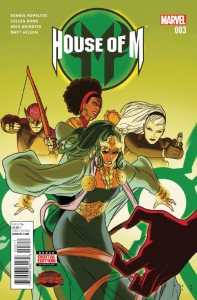 Costa; Art: Andre Aravjo; Colors: Rachelle Rosenberg
Costa; Art: Andre Aravjo; Colors: Rachelle Rosenberg
Secret Wars: Spider Island #4 (of 5) — Writer: Christos Gage; Art: Paco Diaz; Colors: Frank D’Armata
Seven Secret Wars books this week, and three are conclusions (I could swear a couple of the others were originally listed as four-part series, not five, but OK…). Age of Apocalypse has the title (and soon-to-be movie) 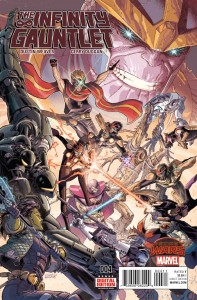 bad guy releasing the Legacy Virus, and mutants starting to drop like flies from it (including a couple of surprising ones — one of the advantages of an alternate-future tale is that the creators are free to go all scorched-earth on everyone, as anyone who got a charge out of the grand-daddy of such stories, the Claremont/Byrne “Days of Future Past,” can attest). Your take on all of this will depend on your fondness for its dark, dystopian tone, and whether you liked the original Apocalypse comics; if you’ve never read them, good luck relating to these. Guardians of Knowhere is a lot more contemporary, using as it does the recent Guardians of the Galaxy book as a jumping-off point;
bad guy releasing the Legacy Virus, and mutants starting to drop like flies from it (including a couple of surprising ones — one of the advantages of an alternate-future tale is that the creators are free to go all scorched-earth on everyone, as anyone who got a charge out of the grand-daddy of such stories, the Claremont/Byrne “Days of Future Past,” can attest). Your take on all of this will depend on your fondness for its dark, dystopian tone, and whether you liked the original Apocalypse comics; if you’ve never read them, good luck relating to these. Guardians of Knowhere is a lot more contemporary, using as it does the recent Guardians of the Galaxy book as a jumping-off point; 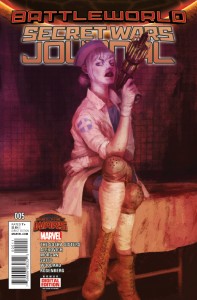 Deodato’s an excellent artist, and Bendis gives him plenty to do, between the Guardians, the Nova Corps, Angela Thor, and that blue Kree warrior woman from Thanos’s crew, who came from the original destroyed Marvel universe and shows up here to freak everyone out. The conclusion indicates that this will wrap back into the main Secret Wars title, and into the new Guardians relaunch in a month, so completist fans will find that more than enough reason to buy it. House of M has Quicksilver teaming up with the Sub-Mariner to depose his father, Magneto, as baron of their region of Battleworld, with a reality-warping Wanda as the wild card. This is slightly lighter in tone than Age of Apocalypse, thanks to the less-shadowy art, but, like that title, it involves a number of alternate
Deodato’s an excellent artist, and Bendis gives him plenty to do, between the Guardians, the Nova Corps, Angela Thor, and that blue Kree warrior woman from Thanos’s crew, who came from the original destroyed Marvel universe and shows up here to freak everyone out. The conclusion indicates that this will wrap back into the main Secret Wars title, and into the new Guardians relaunch in a month, so completist fans will find that more than enough reason to buy it. House of M has Quicksilver teaming up with the Sub-Mariner to depose his father, Magneto, as baron of their region of Battleworld, with a reality-warping Wanda as the wild card. This is slightly lighter in tone than Age of Apocalypse, thanks to the less-shadowy art, but, like that title, it involves a number of alternate 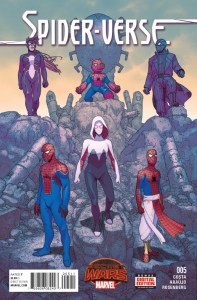 versions of characters that the reader isn’t very likely to care a lot about. Infinity Gauntlet is the same, but even more so: there’s a lot of death here, but not necessarily of anyone we’ve had time to get to know; its main attraction is Thanos as the bad guy — but is it the Thanos who came from the earlier Marvel universe, who’s a major player, or a pale alternate version of him? If he really has an almost-complete Infinity Gauntlet, will that make a difference, and impact the main SW story, or, like most of these mini-series, will it all fade away by the conclusion next issue? At least that’s not a concern with Secret Wars Journal, whose purpose is to be an anthology title, with two smaller stories of the Battleworld denizens in each issue: here, the Night Nurse tale is effective but depressing, while the
versions of characters that the reader isn’t very likely to care a lot about. Infinity Gauntlet is the same, but even more so: there’s a lot of death here, but not necessarily of anyone we’ve had time to get to know; its main attraction is Thanos as the bad guy — but is it the Thanos who came from the earlier Marvel universe, who’s a major player, or a pale alternate version of him? If he really has an almost-complete Infinity Gauntlet, will that make a difference, and impact the main SW story, or, like most of these mini-series, will it all fade away by the conclusion next issue? At least that’s not a concern with Secret Wars Journal, whose purpose is to be an anthology title, with two smaller stories of the Battleworld denizens in each issue: here, the Night Nurse tale is effective but depressing, while the  Millie the Model one (she’s an eternally-optimistic robot emissary of Doom, a clever conceit, anyway…) is more humorous but doesn’t exactly have a happy ending, either. At least the Spider-Secret-Wars titles have known how to stick their landings in their finales; Renew Your Vows last week managed it, and Spider-Verse does it this week, too, with its team of misfit Spider-Men (and Women) mostly intact in its conclusion. Presumably, Spider Island will do the same; although its penultimate issue this week leaves its heroes in a perilous cliffhanger, that’s standard procedure for comics, and writer Gage has been writing Spidey long enough to know that it’s his optimistic nature that usually shines through, even on Doom’s world.
Millie the Model one (she’s an eternally-optimistic robot emissary of Doom, a clever conceit, anyway…) is more humorous but doesn’t exactly have a happy ending, either. At least the Spider-Secret-Wars titles have known how to stick their landings in their finales; Renew Your Vows last week managed it, and Spider-Verse does it this week, too, with its team of misfit Spider-Men (and Women) mostly intact in its conclusion. Presumably, Spider Island will do the same; although its penultimate issue this week leaves its heroes in a perilous cliffhanger, that’s standard procedure for comics, and writer Gage has been writing Spidey long enough to know that it’s his optimistic nature that usually shines through, even on Doom’s world.
 Agent Carter: S.H.I.E.L.D. Anniversary #1 (of 1) — Writer: Kathryn Immonen; Art: Rich Ellis; Colors: Rachelle Rosenberg
Agent Carter: S.H.I.E.L.D. Anniversary #1 (of 1) — Writer: Kathryn Immonen; Art: Rich Ellis; Colors: Rachelle Rosenberg
Captain America: White #1 (of 5) — Writer: Jeph Loeb; Art: Tim Sale; Colors: Dave Stewart
Two regular Marvel books — Agent Carter‘s creative team, Kathryn Immonen and Rich Ellis, also did the Operation: SIN mini-series starring her earlier this year, and this one-shot set in 1966 makes her just as kick-ass, smart and relatable as that story (and the TV series from which most people know her) did; it’s worth reading. Captain 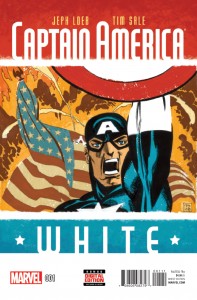 America: White is by the Loeb/Sale team also responsible for Daredevil: Yellow, Spider-Man: Blue and Hulk: Grey; it was originally announced over seven years ago, but since it’s set in the early days of the Avengers, right after Cap is unfrozen from the ice and still mourning the loss of his partner, the delay hasn’t really affected it. Thankfully, there isn’t a lot of moping (the old Stan Lee Cap stories in the ’60s had him angsting about Bucky in every single issue), because a lot of the book is a flashback to the duo’s Howling Commando-joining, Nazi-butt-kicking days, and there’s a zippy Golden Age energy there that keeps everything moving entertainingly, and lets Sales’s unique art stand out.
America: White is by the Loeb/Sale team also responsible for Daredevil: Yellow, Spider-Man: Blue and Hulk: Grey; it was originally announced over seven years ago, but since it’s set in the early days of the Avengers, right after Cap is unfrozen from the ice and still mourning the loss of his partner, the delay hasn’t really affected it. Thankfully, there isn’t a lot of moping (the old Stan Lee Cap stories in the ’60s had him angsting about Bucky in every single issue), because a lot of the book is a flashback to the duo’s Howling Commando-joining, Nazi-butt-kicking days, and there’s a zippy Golden Age energy there that keeps everything moving entertainingly, and lets Sales’s unique art stand out.
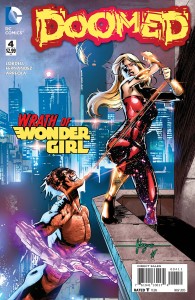 Doomed #4 — Writer: Scott Lobdell; Art: Javier Fernandez; Colors: Ulises Arreola
Doomed #4 — Writer: Scott Lobdell; Art: Javier Fernandez; Colors: Ulises Arreola
Bizarro #4 (of 6) — Writer: Heath Corson; Art: Gustavo Duarte; Colors: Pete Pantazis and Lee Loughridge
Black Canary #4 — Writer: Brenden Fletcher; Art: Pia Guerra; Colors: Lee Loughridge
Constantine: The Hellblazer #4 — Writers: Ming Doyle and James Tynion IV; Art: Vanesa del Rey and Chris  Visions; Colors: Ivan Plascencia
Visions; Colors: Ivan Plascencia
Doctor Fate #4 — Writer: Paul Levitz; Art: Sonny Liew; Colors: Lee Loughridge
Martian Manhunter #4 — Writer: Rob Williams; Pencils: Eddy Barrows; Inks: Eber Ferreira; Colors: Gabe Eltaeb
Prez #4 (of 6) — Writer: Mark Russell; Pencils: Domo Stanton; Inks: Mark Morales and Sean Parsons; Colors: 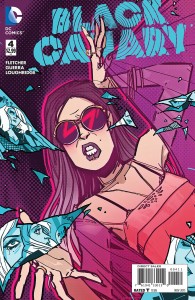 Jeremy Lawson
Jeremy Lawson
Robin, Son of Batman #4 — Writer/Artist: Patrick Gleason; Inks: Mick Gray; Colors: John Kalisz
All of those DC books launched back at the beginning of summer, post-Divergence, are now on their fourth issues, so let’s check in on them. Doomed, sadly, has already been cancelled (the news was announced just a couple of days ago), but it’s not much of a surprise; the book’s first few issues were slow-moving and didn’t give readers much 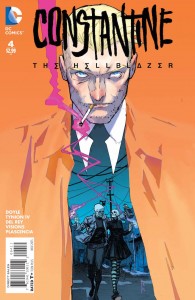 reason to care about its Doomsday-virus-infected main character, and so readers who sampled them didn’t come back. Too bad, because with this fourth issue (guest-starring Wonder Girl, from writer Lobdell’s New-52 Teen Titans book), there are hints of a larger story around the character that might have developed into something. In today’s market you’ve got to hook readers early, though, and this series might have been too focused on writing for the trade to tempt the audience it needed to stay alive. That’s not a problem for Bizarro, since it was always just a
reason to care about its Doomsday-virus-infected main character, and so readers who sampled them didn’t come back. Too bad, because with this fourth issue (guest-starring Wonder Girl, from writer Lobdell’s New-52 Teen Titans book), there are hints of a larger story around the character that might have developed into something. In today’s market you’ve got to hook readers early, though, and this series might have been too focused on writing for the trade to tempt the audience it needed to stay alive. That’s not a problem for Bizarro, since it was always just a  mini-series: its quirky buddy-movie pairing of the offbeat, opposite-talking Superman clone and Jimmy Olson on a road trip has been a pleasant diversion, with lots of guest stars and slapstick humor; in this issue the two switch places (thanks to the always-welcome Zatanna), and even manage to get in a poignant point or two about friendship and understanding one another. Black Canary started strong, piggybacking from the successful style of Fletcher’s hit Batgirl and putting Dinah into a traveling rock band, although this issue bogs down a little in a subplot about her mysterious
mini-series: its quirky buddy-movie pairing of the offbeat, opposite-talking Superman clone and Jimmy Olson on a road trip has been a pleasant diversion, with lots of guest stars and slapstick humor; in this issue the two switch places (thanks to the always-welcome Zatanna), and even manage to get in a poignant point or two about friendship and understanding one another. Black Canary started strong, piggybacking from the successful style of Fletcher’s hit Batgirl and putting Dinah into a traveling rock band, although this issue bogs down a little in a subplot about her mysterious 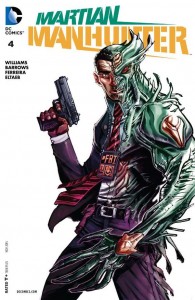 girl companion getting kidnapped by the band’s former singer… or something; sticking to its bright-hued, butt-kicking Jem-and-the-Holograms-meet-Diana-Rigg riffs might maintain its audience better. Constantine has changed its title but is still much the same book, as its character deals with the ghosts of a number of betrayed former acquaintances and lovers, along with an occult menace that turns out to be related to them; the art’s OK, although the Riley Rossmo cover makes me wish he was still drawing the interior, too. Doctor Fate is almost the best book of the lot, with its reluctant save-the-world hero’s character sketched in expertly by old pro Levitz, and drawn with charm and a skillful, light line by Liew. The
girl companion getting kidnapped by the band’s former singer… or something; sticking to its bright-hued, butt-kicking Jem-and-the-Holograms-meet-Diana-Rigg riffs might maintain its audience better. Constantine has changed its title but is still much the same book, as its character deals with the ghosts of a number of betrayed former acquaintances and lovers, along with an occult menace that turns out to be related to them; the art’s OK, although the Riley Rossmo cover makes me wish he was still drawing the interior, too. Doctor Fate is almost the best book of the lot, with its reluctant save-the-world hero’s character sketched in expertly by old pro Levitz, and drawn with charm and a skillful, light line by Liew. The 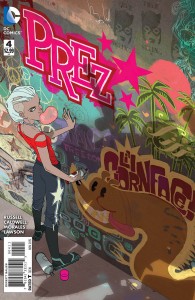 best book, though, is Martian Manhunter, with its surprising twists on the old Martian-invasion plot (J’onn’s dead, except that he’s really fragmented his consciousness and powers into a bunch of his seemingly-human avatars who’ve been living among us, none of them aware that they aren’t actually human — so it’s a race for the avatars to figure out what’s going on, hook up, and reintegrate before the invaders find and kill them). It’s a very fast-moving horror/suspense plot with sharp characterization and some decent special effects, and a lot of fun. “Fun” also applies to Prez; it was another slow starter (it’s only in this fourth issue that the title character has actually become President), but like Bizarro is a mini-series: originally listed as twelve issues, now it’s supposed to be two six-
best book, though, is Martian Manhunter, with its surprising twists on the old Martian-invasion plot (J’onn’s dead, except that he’s really fragmented his consciousness and powers into a bunch of his seemingly-human avatars who’ve been living among us, none of them aware that they aren’t actually human — so it’s a race for the avatars to figure out what’s going on, hook up, and reintegrate before the invaders find and kill them). It’s a very fast-moving horror/suspense plot with sharp characterization and some decent special effects, and a lot of fun. “Fun” also applies to Prez; it was another slow starter (it’s only in this fourth issue that the title character has actually become President), but like Bizarro is a mini-series: originally listed as twelve issues, now it’s supposed to be two six-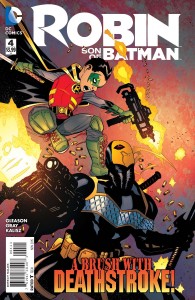 issue ones, presumably so they can see how the first collection does before green-lighting the second. Its satire has gotten more scalpel-like, sharp-edged and precise, and although its targets are obvious ones (corrupt businessmen, lickspittle politicians, etc.), the current political climate lends it a relevance and bite that might help it to survive. Robin‘s gotten better as it’s gone on, too, with Gleason-the-artist solid from the beginning, and Gleason-the-writer getting more of a handle on his young, arrogant and ultra-competent title character, and managing to make him both appealing and appalling; the guest villain this issue, Deathstroke, makes a perfect match for him, and their conflict leads to an unexpected, but logical, conclusion.
issue ones, presumably so they can see how the first collection does before green-lighting the second. Its satire has gotten more scalpel-like, sharp-edged and precise, and although its targets are obvious ones (corrupt businessmen, lickspittle politicians, etc.), the current political climate lends it a relevance and bite that might help it to survive. Robin‘s gotten better as it’s gone on, too, with Gleason-the-artist solid from the beginning, and Gleason-the-writer getting more of a handle on his young, arrogant and ultra-competent title character, and managing to make him both appealing and appalling; the guest villain this issue, Deathstroke, makes a perfect match for him, and their conflict leads to an unexpected, but logical, conclusion.
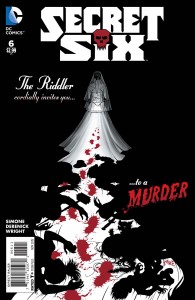 Secret Six #6 — Writer: Gail Simone; Art: Tom Derenick; Colors: Jason Wright
Secret Six #6 — Writer: Gail Simone; Art: Tom Derenick; Colors: Jason Wright
Superman/Wonder Woman #21 — Writer: Peter Tomasi; Pencils: Doug Mahnke; Inks: Four different guys; Colors: Three different guys
Two other DC books — Secret Six isn’t much further along than the other “new” books, but has been around in earlier incarnations for quite a while, all under Simone’s steady guidance; this version, with Catman continuing as our focus but surrounded by some new and some old 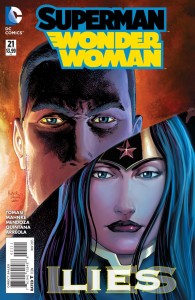 characters (including one whose real identity turned out to be an inspired surprise), concludes its first arc with the usual mayhem, cynical humor, reluctant bonding by its cast of misfits and strays, and sudden cliffhanger at the end to bring readers back for its next installment. Superman/Wonder Woman, meanwhile, concludes its current story, about Clark confronting a US government that now knows his secrets, and has detained many of his Smallville friends and other acquaintances to interrogate about him; Mahnke’s gritty-but-attractive art makes a good match for his less-powered but just-as-determined personality here, although the tag-team inking and coloring does it no favors.
characters (including one whose real identity turned out to be an inspired surprise), concludes its first arc with the usual mayhem, cynical humor, reluctant bonding by its cast of misfits and strays, and sudden cliffhanger at the end to bring readers back for its next installment. Superman/Wonder Woman, meanwhile, concludes its current story, about Clark confronting a US government that now knows his secrets, and has detained many of his Smallville friends and other acquaintances to interrogate about him; Mahnke’s gritty-but-attractive art makes a good match for his less-powered but just-as-determined personality here, although the tag-team inking and coloring does it no favors.
 Tokyo Ghost #1 — Writer: Rick Remender; Art: Sean Murphy; Colors: Matt Hollingsworth
Tokyo Ghost #1 — Writer: Rick Remender; Art: Sean Murphy; Colors: Matt Hollingsworth
The Paybacks #1 — Writers: Donny Cates and Eliot Rahal; Art: Geoff Shaw; Colors: Lauren Affe
A couple of indy debuts — Tokyo Ghost is yet another Rick Remender ongoing title (along with Deadly Class, Low and Black Science), about a half-flooded future LA patrolled by corporate cops; it’s about two of them, a former couple where the guy is hard-wired into digital entertainment and nano-enhancers, like most of the population, and the woman is tech-free. It’s action-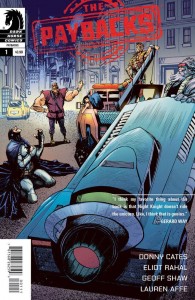 packed, and also an off-kilter love story; Remender name-checks Judge Dredd, Road Warrior and 13 Assassins in the editorial material, and Murphy, who’s drawn Joe the Barbarian, Punk Rock Jesus and The Wake, is good at providing the mix of relatable human expressions and high-tech battle scenes that are required. The Paybacks has a high-concept hook: it’s about a super-repo team, who go after heroes who’ve used loans to buy their vehicles, super-suits, hideouts, etc. but haven’t kept up the payments, and now are in delinquency. Cool idea, and it’s done with both humor and drama, although this first issue has to pack in a bunch of characters and backgrounds to get readers up to speed, and so risks overwhelming them.
packed, and also an off-kilter love story; Remender name-checks Judge Dredd, Road Warrior and 13 Assassins in the editorial material, and Murphy, who’s drawn Joe the Barbarian, Punk Rock Jesus and The Wake, is good at providing the mix of relatable human expressions and high-tech battle scenes that are required. The Paybacks has a high-concept hook: it’s about a super-repo team, who go after heroes who’ve used loans to buy their vehicles, super-suits, hideouts, etc. but haven’t kept up the payments, and now are in delinquency. Cool idea, and it’s done with both humor and drama, although this first issue has to pack in a bunch of characters and backgrounds to get readers up to speed, and so risks overwhelming them.
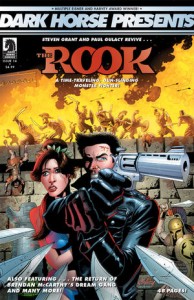 Dark Horse Presents #14 — Creators: Various
Dark Horse Presents #14 — Creators: Various
The Fade-Out #9 — Writer: Ed Brubaker; Art: Sean Phillips
Groo: Friends and Foes #9 (of 12) — Story/Art: Sergio Aragones; Wordsmith: Mark Evanier
Island #3 — Creators: Various
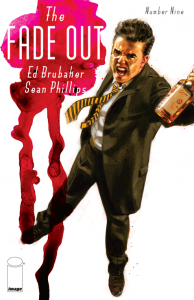 Lumberjanes #18 — Writers: Shannon Watters and Kat Leyh; Art: Carolyn Nowak; Colors: Maarta Laiho
Lumberjanes #18 — Writers: Shannon Watters and Kat Leyh; Art: Carolyn Nowak; Colors: Maarta Laiho
Sex Criminals #12 — Writer: Matt Fraction; Art/Colors: Chip Zdarsky
The Simpsons’ Treehouse of Horror #21 — Creators: Various
 The Spirit #3 — Writer: Matt Wagner; Art: Dan Schkade; Colors: Brennan Wagner
The Spirit #3 — Writer: Matt Wagner; Art: Dan Schkade; Colors: Brennan Wagner
Usagi Yojimbo #148 — Writer/Artist: Stan Sakai
Everything else: Dark Horse Presents has a revival of the old Warren magazine title The Rook, about a time-travelling gunslinger, and it’s got Paul Gulacy art; there’s also a new chapter of a story by British psychedelic artist Brendan McCarthy, and an episode of the always- intriguing (and sometimes disgusting, but in a good way) occult thriller Semiautomagic, by Alex de Campi and Jerry Ordway, who make a very polished and cinematic team. The Fade Out is another issue of that old-Hollywood noir thriller, while Groo is, as always, a story about that dimwitted barbarian drawn by the eternally-amazing Sergio Aragones and written with the help of Mark Evanier; this issue guest-stars the supporting characters
intriguing (and sometimes disgusting, but in a good way) occult thriller Semiautomagic, by Alex de Campi and Jerry Ordway, who make a very polished and cinematic team. The Fade Out is another issue of that old-Hollywood noir thriller, while Groo is, as always, a story about that dimwitted barbarian drawn by the eternally-amazing Sergio Aragones and written with the help of Mark Evanier; this issue guest-stars the supporting characters 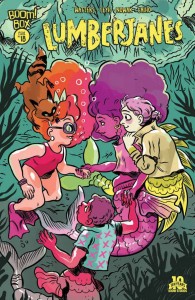 Pal ‘n Drumm, a tribute to those buddy pairs where one’s the smart little guy, and the other’s the big dim one. Island is another installment of the cutting-edge anthology series put together by Brandon Graham and Emily Rios; for $7.99, it offers over 100 pages of art and story by a bunch of amazing indy talent: twenty pages by the brand-new Amy Clare, who combines some sophisticated design elements with a style reminiscent of Graham’s own and steals the show; almost thirty pages of
Pal ‘n Drumm, a tribute to those buddy pairs where one’s the smart little guy, and the other’s the big dim one. Island is another installment of the cutting-edge anthology series put together by Brandon Graham and Emily Rios; for $7.99, it offers over 100 pages of art and story by a bunch of amazing indy talent: twenty pages by the brand-new Amy Clare, who combines some sophisticated design elements with a style reminiscent of Graham’s own and steals the show; almost thirty pages of  the first installment of an sf story about everyone being wired into social media, and a revolutionary trying to unplug them, by Malachi Ward and Matt Sheean, that plays like an episode of a new series on some quirky-cool cable channel; almost twenty pages by Dilraj Mann, who uses urban-artscene settings and characters in a style a little like Charles Burns, that wouldn’t have been out of place in the old Raw; twenty pages of a quietly-devastating wilderness-survival story by Kate Craig, with really nice coloring; and a couple of other
the first installment of an sf story about everyone being wired into social media, and a revolutionary trying to unplug them, by Malachi Ward and Matt Sheean, that plays like an episode of a new series on some quirky-cool cable channel; almost twenty pages by Dilraj Mann, who uses urban-artscene settings and characters in a style a little like Charles Burns, that wouldn’t have been out of place in the old Raw; twenty pages of a quietly-devastating wilderness-survival story by Kate Craig, with really nice coloring; and a couple of other  entries, too: anyone who wants to feel upbeat about the next generation of comics creators should get this comic. Add in a new issue of Lumberjanes, with Carolyn Nowak taking over art chores from Brooke Allen and, although her style is more bigfoot/slapstick, not missing a beat (it helps that she did issues 10-12 earlier this year), with a couple of priceless group reaction shots. Sex Criminals offers another chapter of its tale of people whose orgasms give them
entries, too: anyone who wants to feel upbeat about the next generation of comics creators should get this comic. Add in a new issue of Lumberjanes, with Carolyn Nowak taking over art chores from Brooke Allen and, although her style is more bigfoot/slapstick, not missing a beat (it helps that she did issues 10-12 earlier this year), with a couple of priceless group reaction shots. Sex Criminals offers another chapter of its tale of people whose orgasms give them 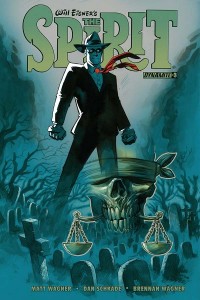 super-powers, like stopping time (and, if that sounded stupid, you really need to pick up the first trade and read it from the beginning, because it’s actually an awesome comic); although this installment is even weirder than most, it’s also got a hilarious three-page article from Fraction about all the things that went wrong with last issue’s attempt to bag the issue and include random personal sketches in some of them. Now that the night-time lows in Phoenix are dipping under eighty
super-powers, like stopping time (and, if that sounded stupid, you really need to pick up the first trade and read it from the beginning, because it’s actually an awesome comic); although this installment is even weirder than most, it’s also got a hilarious three-page article from Fraction about all the things that went wrong with last issue’s attempt to bag the issue and include random personal sketches in some of them. Now that the night-time lows in Phoenix are dipping under eighty  degrees (what we here call “fall”) it’s time for The Simpson’s Treehouse of Horror; this is the 21st year that Bongo has produced one, and that, and a look at the cover, should be enough to get you to buy it. The Spirit is worthwhile because it’s written by Matt Wagner, who knows his pulpy source material, and because artist Dan Sckade is starting to shake off the Eisner intimidation and add some of his own touches, while Usagi Yojimbo, like Groo, is always, always a good comic: this issue, like most, is a done-in-one-issue story, and a perfect reason to pick it up and see why its fans are all so hooked on Stan Sakai’s leporine samurai.
degrees (what we here call “fall”) it’s time for The Simpson’s Treehouse of Horror; this is the 21st year that Bongo has produced one, and that, and a look at the cover, should be enough to get you to buy it. The Spirit is worthwhile because it’s written by Matt Wagner, who knows his pulpy source material, and because artist Dan Sckade is starting to shake off the Eisner intimidation and add some of his own touches, while Usagi Yojimbo, like Groo, is always, always a good comic: this issue, like most, is a done-in-one-issue story, and a perfect reason to pick it up and see why its fans are all so hooked on Stan Sakai’s leporine samurai.



